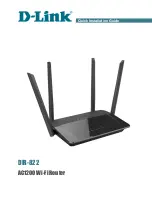
Policy NAT
Policy NAT allows you to identify the real address for the address translation by specifying the source and
destination address in an extended access list. You can specify the source and destination ports. The Policy
NAT allows you to create flexible NAT rules for advanced users. Please understand the capabilities of the
feature and your use case before configuring the rules. Invalid settings may be accepted but they may not
work. For most users, it is recommended to use the Port Forwarding or Static NAT instead.
Dynamic address translation (DNAT), is an enhanced form of NAT which involves the router translating the
IP address but not the port number. This dynamic approach is used for mapping the addresses of large numbers
of internal computers to a few routable IP addresses. For DNAT, you should set the "To interface" as
any
.
Note
To configure the Policy NAT, follow these steps:
Step 1
Choose
Firewall > Policy NAT
.
Step 2
Click
Add
to add a new policy NAT rule.
Step 3
Enter the name for the new policy NAT rule.
Step 4
Check
Enable
to enable the policy NAT.
Step 5
In the From Interface section, select the interface from the drop-down list.
Step 6
In the To Interface section, select the interface from the drop-down list.
Step 7
In the Source Address section, select
Any
or
Use a new IP Group
to create a new address. Next, check the Translated
box and select an option from the drop-down list.
Step 8
In the Destination Address section, select
Any
or
Use a new IP Group
to create a new address. Next, check the
Translated box and select an option from the drop-down list.
Step 9
In the Service section, select an option from the drop-down list. Next, check the box and select the Translated option
from the drop-down list.
IP source address or group can be created or selected from IP address groups page under the System
configuration page. If it is a service management record, the page is directed to Service Management page
under IP address group.
Note
Step 10
Click
Apply
.
Step 11
Click
Edit
or
Delete
to edit or delete an existing Policy NAT.
Step 12
Click
Apply
.
Policy NAT Use Cases
Policy NAT allows you to identify real addresses for address translation by specifying the source and destination
addresses in an extended access list. You can specify the source and destination ports. Regular NAT can only
consider the source addresses, not the destination address. For example, with policy NAT you can translate
the real address to a mapped address when it accesses a specific server, but also translate the real address to
a mapped address when it accesses a designated server. The following are use case examples for Policy NAT.
RV260x Administration Guide
83
Firewall
Policy NAT
Содержание RV260 series
Страница 8: ...RV260x Administration Guide viii Contents ...
Страница 18: ...RV260x Administration Guide 10 Getting Started User Interface ...
Страница 30: ...RV260x Administration Guide 22 Status and Statistics Captive Portal Status ...
Страница 38: ...RV260x Administration Guide 30 Administration Copy Save Configuration ...
Страница 54: ...RV260x Administration Guide 46 System Configuration Registering Devices ...
Страница 80: ...RV260x Administration Guide 72 Wireless Lobby Ambassador ...
Страница 84: ...RV260x Administration Guide 76 Routing IGMP Proxy ...
Страница 96: ...RV260x Administration Guide 88 Firewall DMZ Host ...
Страница 122: ...RV260x Administration Guide 114 QoS Switch Queuing ...
Страница 124: ...RV260x Administration Guide 116 Where To Go Where To Go From Here ...
















































